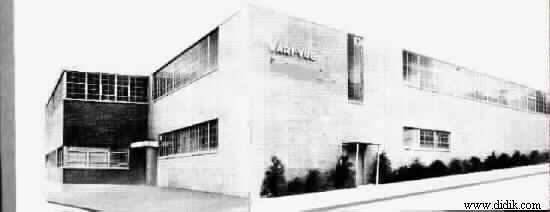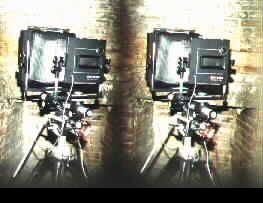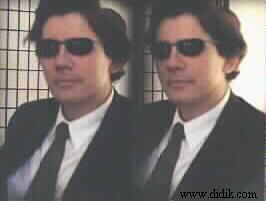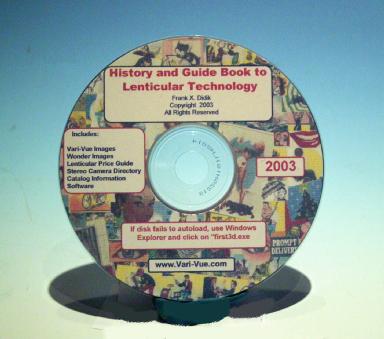|
General
Information
Welcome to the DIDIK/Vari-Vue™
Lenticular/Stereographic website - the popularizer of the Lenticular
process. In 1936 the modern Lenticular image was patented and this
formed the seed which led to the formal incorporation of the Vari-Vue
company in 1948. Vari-Vue popularized Lenticular technology
world-wide and by the 1950's, had become a household word. In the
1960's and early 1970's, Vari-Vue created a network of Lenticular
license holders world wide which greatly increased the recognition of
this technology. Vari-Vue has been the world leader in stereo (3D)
and animated printing. For over 60 years, virtually every advancement
in the field of Lenticular technology has been developed by Vari-Vue
including specialty plastics for maximum refractive indexes and mass
production, an enormous variety of Lenticular lenses (linear lenses)
ranging from from 1 lens per inch to 360 lenses per inch and a
variety of varying focal lengths for each of the lenses, special
optical glues which enhance clarity, have little bubble formation and
can endure humid, dry, hot and cold climates. In addition, Vari-Vue
developed many of the high speed Lenticular production equipment,
including sheet fed, continuous run equipment as well as
"auto-stereo" large format cameras to which the bulk of all
Lenticular images on the planet was shot with. Starting in the early
1960's, Vari-Vue licensed these advancements to companies on all
continents. To this day, many, if not most, of these high speed, mass
production equipment and techniques remain trade secrets. It is one
thing to produce a singe or a couple of medium grade lenticulars on a
computer that, when laminated, will last for a few months or, with
luck, a few years. It is quit another thing to produce hundreds of
millions of high quality lenticulars per year that will last
indefinitely, through humidity and temperature changes and, at the
same time, be economically viable to manufacture. The
technology that we have can do just this. In addition, with the wide
variety of Lenticular lenses, many viewing distances can be achieved
-- with quality and resolution in mind. Lenticular lenses are far
more complex then simply lines per inch. For example, it is possible
to have a variety of different focal length lenses having the same
number of lines per inch. This is for different viewing distances. In
addition, the type of plastic and the additive incorporated into the
plastics while being manufactured significantly effects the
refractive index and capabilities and quality of the final image.
Special outer coatings of the Lenticular lens also effects the final
image quality. Vari-vue spent, what amounts to a fortune in research
in these areas. In addition, the cost to produce a master Lenticular
lens die was very high, since only the finest machine tools can
achieve the necessary quality. To give you an example, the cost to
produce a singe 40 line 12" x 16" master die was, according
to our records, $27,000 ... in 1974! Today, even with CNC machine
tools, the cost would be substantially higher. We have a variety of
dies for many types of lenses, on hand.
Today, thousands of people world wide collect early Vari-Vue images.
Some of these images sell for thousands of dollars. These lenticulars
range from the earliest images of the 30's and 40's, to stereo and
animated images of Elvis Presley, The Beatles, Rolling Stones,
politicians such as Eisenhower, the so called "Op-Art" of
the 1960's, full sized highway billboards, conversion tools, 3-D
posters, 1939-40 and 1964-65 New York Worlds Fair items, drinking
glasses, record and music album covers, games, eye glasses, charms,
jewelry, greeting cards, point of sale images and countless other
images. Virtually every major American Company and many, foreign
companies had Lenticular images produced by Vari-Vue in the 1950's
through the 1970's. Today, there has been a resurgence in Lenticular
image technology and Didik.com is in the forefront of Lenticular
development and new uses for our Lenticular technology. We also
maintain what is probably the worlds largest Lenticular image
collection. This collection is available to museums and special shows.
If you are interested in Lenticular
technology or collecting early Lenticular
images, you may wish to purchase the "The History and Guide
Book to Lenticular Technology and Images on CD-ROM". This
master directory covers and illustrates thousands of lenticulars with
original prices and index codes and gives insight into the
technology. It contains over 100 megabytes of information. If you are
interested in this product, CLICK
HERE for more details.
For further information, please refer to the pages below. Thank You.
DIDIK/Vari-Vue
Stereo 3-D Pages
CONTACT
US
+1 
**"Lenticular"
is a trade name used by Vari-Vue™ to describe linier lenses and
was coined in a 1936 patent covering lenticular technology which led
to the formal formation of Vari-Vue™ in 1948..
If
you would like to be placed on our mailing list or if you would like
information on our Lenticular
printing service, blank Lenticular
lenses, Lenticular image guide book or if you are a member of the
media and would like to receive our press kit, please register below:
|
Press
CTRL D now, to bookmark this site

The
second Vari-Vue™ factory in Yonkers, New York (USA) as seen in
this 1962 photograph. Over 200 million Lenticular images per year
were produced at this 50,000 sqft (approximately 5,000 sq meter)
factory from 1957 till 1972. In late 1972, Vari-Vue moved to a more
modern facility in Pehlem, New York, where it remained till 1986 when
most of the production line and intellectual property was purchase by DIDIK.

One
of the many varieties of Auto-Stereo cameras designed and built by Vari-Vue.
This particular camera shot most of the famous Lenticular postcards
in the 1950's and 1960's. It is capable of taking an unlimited number
of photographs of the same image, each varying only slightly from one another.

A
stereo pair is another type of stereo image. This type of image can
be viewed in 3-D by placing a divider between the two images and
looking straight. For more info on viewing, please review the site as
listed in the left column. Stereo Pairs were originally conceived in
1838-- only 9 years after the first photograph was shot (1829) and
two years before Degarue came out with a type of photography that was
later to be known as the Dagarutype.

Vari-Vue™
"INTERNATIONAL" logo as adapted in 1948
Press
CTRL D now, to bookmark this site

 The
History and Guide Book to Lenticular Technology and Images on
CD-ROM. This is an ABSOLUTE MUST for any one interested in 3-D or who
collects lenticulars. It covers and illustrates thousands of
lenticulars and gives insight into the technology. CLICK
HERE for more information. The
History and Guide Book to Lenticular Technology and Images on
CD-ROM. This is an ABSOLUTE MUST for any one interested in 3-D or who
collects lenticulars. It covers and illustrates thousands of
lenticulars and gives insight into the technology. CLICK
HERE for more information. |